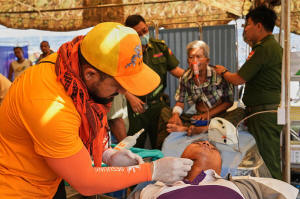In the race to save lives after the Myanmar quake, US rescuers are
notable by their absence
[April 05, 2025]
By ELLEN KNICKMEYER and DAVID RISING
WASHINGTON (AP) — Day after day, Chinese rescue teams haul children and
elderly people from collapsed buildings as cameras beam the thanks of
grateful survivors around the world. Russian medical teams show off
field hospitals erected in a flash to tend the wounded.
Notably absent from the aftermath of the 7.7-magnitude earthquake in the
poor Southeast Asian nation Myanmar: the uniquely skilled, well-equipped
and swift search-and-rescue teams and disaster-response crews from the
United States.
At least 15 Asian and Western government rescue teams have landed crews
reaching hundreds of workers in size, alongside initial pledges of
financial aid reaching tens of millions of dollars, as the death toll of
the March 28 quake tops 3,000, Myanmar's government says. Cameras showed
Vietnam's team on arrival, marching square-shouldered to the rescue
behind their country's flag.
While Myanmar’s military junta and civil war have posed challenges, the
U.S. government has worked with local partners there previously to
successfully provide aid for decades, including after deadly storms in
2008 and 2023, aid officials say.
The American government dwarfs other nations' rescue capacity in
experience, capacity and heavy machinery able to pull people alive from
rubble. But in Myanmar after the most recent quake, the U.S. has
distinguished itself for having no known presence on the ground beyond a
three-member assessment team sent days after the quake.
“We all worried what would be the human impact” of President Donald
Trump’s dismantling of the six-decade-old U.S. Agency for International
Development, said Lia Lindsey, a senior humanitarian policy adviser for
Oxfam, which scrambled to provide tents, blankets and other aid to quake
survivors.

Now, Lindsey said, "we're seeing it in real time. We’re seeing it in
increased suffering and increased death.”'
A retreat from decades of American policy may be fueling the absence
The United States, the world’s largest economy, long saw its strategic
interests and alliances served by its standing as the world’s top
humanitarian donor. Myanmar's quake is as close to a no-show as the
nation has had in recent memory at a major, accessible natural disaster.
Current and former senior private and government officials say the
Myanmar disaster points to some of the results — for people in need on
the ground, and for U.S. standing in the world — of the Trump
administration's retreat from decades of U.S. policy. That approach held
that Washington needs both the hard power of a strong military and the
soft power of a robust aid and development program to deter enemies, win
and keep friends and steer events.
Secretary of State Marco Rubio, in Europe for a NATO gathering, rejected
a suggestion that the administration was ceding influence abroad by
canceling thousands of its aid and development contracts, including for
disasters. He told reporters that those complaining were the aid groups,
which he accused of profiting off past U.S. aid.
“We will do the best we can," Rubio said Friday. “But we also have other
needs we have to balance that against. We’re not walking away."
He pointed to “a lot of other rich countries in the world. They should
all be pitching in and do their part.”
Leading Senate Democrats wrote Rubio this week, urging him to scale up
U.S. disaster aid to Myanmar — and fast. Separately, Delaware Sen. Chris
Coons, a Democratic member of the Senate Foreign Relations Committee,
spoke of watching a news broadcast of the disaster showing Chinese
government teams at work.
“It hurt my heart to see where, instead of a USAID ... team leading the
response, there was a team from the PRC that was being celebrated for
having saved some people in the rubble,” Coons said.
The 2 1/2-month-old Trump administration, through Elon Musk's Department
of Government Efficiency teams, has frozen USAID funding, terminated
thousands of contracts and is firing all but a handful of its staff
globally. It accuses the agency of waste and of advancing liberal
causes. The Myanmar quake is the first major natural disaster since that
work started.
The Trump administration and some Republican lawmakers say they will
reassemble a reduced slate of aid and development programs under the
State Department, fitting their narrower interpretation of work that
serves U.S. strategic and economic interests.
The first announcement of help came days later
Days after the Myanmar quake, the U.S. made its first announcement of
help: It was sending a three-member assessment team of non-specialist
advisers from a regional USAID office in Bangkok, Thailand.
Coincidentally, like hundreds of other USAID staffers around the world,
the three had received layoff notices from the Trump administration on
March 28 within hours of the quake, current and former USAID officials
confirmed.
[to top of second column]
|

A Bhutan medical volunteer attends to a patient at their make-shift
tent after last week's earthquake in Naypyitaw, Myanmar, Friday,
April 4, 2025. (AP Photo)

The administration also promised $2 million in aid, and announced
another $7 million Friday. But there's a much larger number at play.
That $9 million total is dwarfed by the roughly $2 billion in
payments for previously rendered services and goods that the Trump
administration has owed nonprofit humanitarian groups and other
contractors and government and nongovernment foreign partners, aid
officials say. The Trump administration abruptly shut down USAID and
State foreign assistance payments — including for work already done
— on Jan. 20, Inauguration Day.
Combined with abruptly terminated aid contracts and the freeze on
the USAID and State aid and development payments, the U.S. back debt
is forcing larger aid operations and businesses to scale back their
services to people in need and to slash staff. Some smaller
organizations were driven out of business. That was even before the
Myanmar quake.
Under court order, the administration is slowly making good on those
back payments.
In the meantime, nonprofit groups are having to draw on reserve
funds they would normally use for sudden unplanned disasters like
the Myanmar quake to pay the bills that the U.S. should have paid,
said Lindsey, the Oxfam official.
Asked about the burden that the non-government organizations —
another name for aid groups — say USAID's unpaid back bills are
placing on their work, the State Department said in an email, “The
U.S. government cannot comment on how NGOs manage their financing."
Typically, the United States itself would have provided $10 million
to $20 million in the initial phase of response to a disaster like
the Myanmar quake, with more later for long-term aid and rebuilding,
said Sarah Charles, who ran disaster response and overall
humanitarian affairs at USAID in the Biden administration.
“We have a long history in Burma,” Charles said, adding, “It’s an
environment that the U.S. government has been operating in over the
last many decades."
Normally, the United States also would have had 20 to 25 specialized
disaster workers on the ground in as few as 24 hours, Charles said.
That number would have jumped to 200 or more if USAID had flown in
urban rescue teams from California and Virginia. They deploy as
self-contained units, with dog handlers and the capacity to feed and
provide clean water to the teams, Charles said.

The Trump administration preserved contracts for the California and
Virginia rescue teams under pressure from lawmakers. But the
contracts for their transport are believed among the thousands of
USAID contracts that the administration canceled. That left the U.S.
no quick way to move search-and-rescue crews when disaster struck,
Charles said.
Britain has pledged $13 million in aid and said it will match up to
$5 million in private donations, and China and others have promised
financial aid. At least 15 countries sent in dozens or hundreds of
rescuers or aid workers, including Russia, China, India and the
United Arab Emirates, according to Myanmar officials.
China shares a border and close ties with Myanmar. Chinese rescuers
had their first success Sunday, fewer than 48 hours after the quake,
when they joined hands with local people to pull an elderly man from
a badly damaged hospital in the capital city of Naypyitaw.
By Wednesday, Chinese rescuers had pulled out nine survivors,
including a pregnant woman and a child. In Mandalay, Chinese
rescuers saved a 52-year-old man who trapped for nearly 125 hours.
—-
Rising reported from Bangkok. Matthew Lee and Didi Tang contributed
from Washington and Jill Lawless from London.
All contents © copyright 2025 Associated Press. All rights reserved
 |